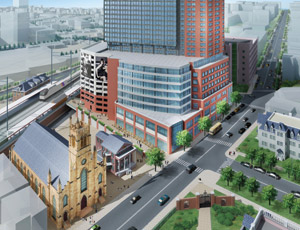PROJECT COST: $150 million
An often-cited benefit of the growth in commuter rail travel has been the opportunity to create economically vibrant transit-oriented developments clustered around stations. The new Gateway Transit Village not only creates this kind of pedestrian-friendly opportunity for downtown New Brunswick, but also provides a long-needed connection between the city's busy Northeast Corridor rail platform and the historic East End entrance to Rutgers University.

Prominently located on a previously underutilized 1.2-acre site at the end of College Avenue, the 625,000 sq ft, 22-story mixed-use complex will provide street-level retail space for a variety of tenants, plus five stories of Class A office space totaling 50,000 sq ft.
A 10-level, 656-car precast concrete parking garage located behind the retail and commercial space will be topped by a 15-story, 245,000 sq ft condominium tower with 200 units that offer views of the Raritan River. Along the northeastern side of the new complex, a sweeping 200-ft long slab-on-grade pedestrian walkway will connect the train station with College Avenue and Rutgers campus while simultaneously providing a landing point for visitors arriving in New Brunswick via train.
Despite its size, Gateway Transit Village was designed to minimize its visual impacts on the area's many historic low-rise structures. The exterior of prefabricated panelized wall systems with thin brick cladding are designed to help the complex blend with the surroundings, including those on the Old Queen's Campus of Rutgers that date to the early 19th Century.
Setting the tower back atop the garage resolved the challenge of maintaining the development's balance and scale, but also presented a key structural engineering challenge.
"Because the most efficient column grid for a garage is different from that of a residential building, we had to combine two structural concepts into one," says EE&K senior associate Mathew Snethen. After evaluating various structural solutions, the team opted to design a precast garage with a standard structural system, topped with a floor of 16-ft transfer beams. From there, the steel-frame and precast tower will rise 295 feet above the train station, making it New Brunswick's tallest building.
"The garage also has additional bracing to help minimize sway in the tower," Snethen adds.
The project's developers are also working with the New Brunswick Historical Association to preserve some of the unique facades of the older buildings currently on site, including historic St. Peter's Roman Catholic Church.
Key Players
Owner: Somerset Street Urban Renewal Associates, LLC, New Brunswick
Development Team: DEVCO, New Brunswick/ Keating Urban Partners, Philadelphia/ Pennrose Properties, Philadelphia
Designer: EE&K Residential, New York
Architect: Meltzer/Mandl Architects, New York
Structural Engineer: Severud Associates, New York
MEP/FP Engineer: Barone Engineering, Butler, NJ (current); AKF Engineers, New York (original)
Civil Engineer: The Louis Berger Group, Morristown, NJ
General Contractor: AJD Construction, Leonardo, NJ

Post a comment to this article
Report Abusive Comment